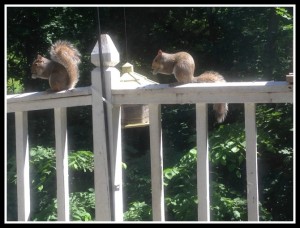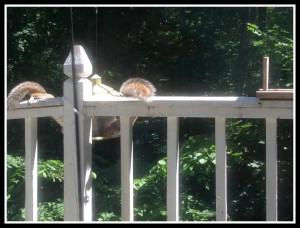 Serendipity Gardens is home to several squirrels. Because it is “out in the country,” the squirrels are not a bother, just fun to watch.
Serendipity Gardens is home to several squirrels. Because it is “out in the country,” the squirrels are not a bother, just fun to watch.
I ran across this book recently on a rare visit to a bookstore. Written by Lyanda Lynn Haupt, an award-winning author, speaker, and naturalist based in Seattle, it caught my eye immediately, not only because of its interesting-looking cover, but also its title.
What is a bestiary? I wondered. And an urban bestiary to boot?
I was intrigued enough to toy with purchasing the book. I even sat down on a bookstore bench to peruse it, but in the end, I did the modern thing. I went home and ordered the Kindle version
A bestiary, it turns out, is, among other things, “a collection of descriptions or representations of real or imaginary animals.” (Miriam-Webster) In medieval times, these descriptions often carried moral overtones or imparted moral lessons to readers.
The book has four main sections: Entering the Bestiary, The Furred, the Feathered, and The Branched and Rooted, which includes humans.
In the first section, The Furred, the author covers these urban animals: coyote, mole, raccoon, possum, squirrel, and black bear and cougar.
A Brief Focus on Squirrels
Recently, I had occasion to watch several very clever squirrels eat all the food in a bird feeder, day after day. No matter what we did to make the feeder inaccessible, they found a way around it. Here are a couple of photos of the little acrobats:
Because of this experience, I read the chapter on squirrels with particular interest. I learned quite a bit about this most familiar form of wildlife. Here are some squirrel facts:
- In studies of backyard wildlife, squirrels rank as both the most desirable and attractive animal and the most hated nuisance animal.
- Urban/suburban squirrels are basically territorial, and claim about half an acre per pair.
- Urban squirrels build more than one nest a year for different purposes, sometimes in the attics of human houses.
- A squirrel nest is called a drey.
- Squirrels use their tails for all sorts of things: to balance while running; to steer while jumping; to cushion a fall; to wrap around its body like a fur coat for warmth; to hold overhead like a parasol for shade; to shield from rain like an umbrella; to swaddle young; to confound and scare off intruders; and to communicate with other squirrels in a surprisingly complex way.
Dealing with Squirrels
While I am working hard to attract wildlife to my garden, it’s still true that many gardeners struggle with animals they do NOT want in their gardens. Not having such animals may become increasingly less likely, as their habitat shrinks and we are forced to live in the same area together. The task may be to learn ways to increase your enjoyment of living with and near wild animals. As with most things, extra knowledge helps, and The Urban Bestiary provides a lot of knowledge.
Are the squirrels in your garden more of a nuisance than a pleasure? If so, here are the tips from The Urban Bestiary to foil them:
- Cover crops squirrels love with netting and full-grown sunflower heads with translucent drawstring bags.
- Plant daffodil bulbs, which squirrels don’t like, instead of tulips, which they do.
- To keep squirrels away from your bird feeders, provide an alternative food source. String peanuts on wires or hang dried corncobs from a branch so they dangle a foot above ground, just out of reach. The squirrels have to work to acquire them — and they may be too busy to bother the birds.
Haupt says it’s best not to feed wild animals, but if you must feed a squirrel, hold the peanut in an outstretched palm rather than between your fingers.
A Recommendation
The author covers many more animals with a similar approach and encourages readers to view the wildlife in their lives as opportunities for growth and learning rather than nuisances to chase away or kill. Elimination rarely works, she says, because more will come to replace the ones that are gone.
This is an approach that certainly makes sense to one who enjoys observing what goes on in a backyard ecosystem. The Urban Bestiary is a good book to read.
Like this post? Sign up to receive an email each time a new post is available. We will never loan, sell or rent your email address — that’s a promise! Please use the buttons below to share with others.

